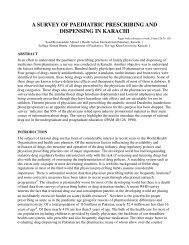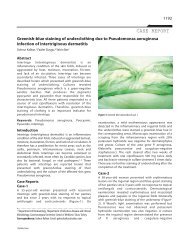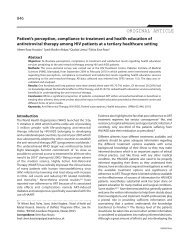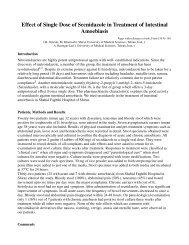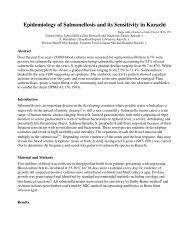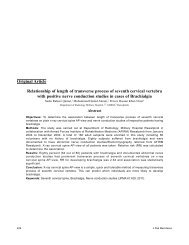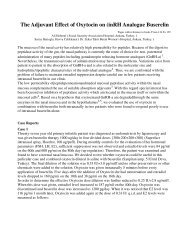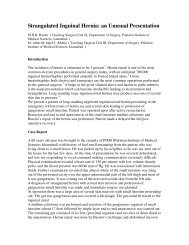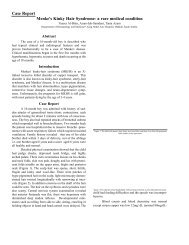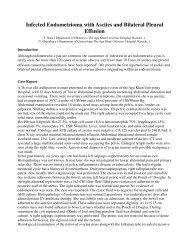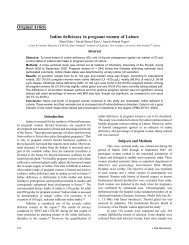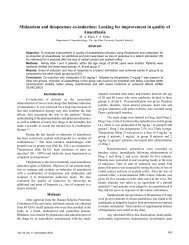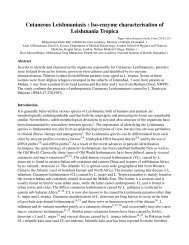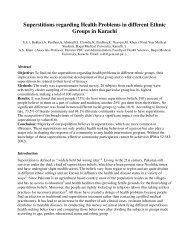Study of Efficacy and Tolerance of Ketoprofen and Diclofenac ...
Study of Efficacy and Tolerance of Ketoprofen and Diclofenac ...
Study of Efficacy and Tolerance of Ketoprofen and Diclofenac ...
You also want an ePaper? Increase the reach of your titles
YUMPU automatically turns print PDFs into web optimized ePapers that Google loves.
<strong>Study</strong> <strong>of</strong> <strong>Efficacy</strong> <strong>and</strong> <strong>Tolerance</strong> <strong>of</strong> Ketopr<strong>of</strong>en <strong>and</strong> Dicl<strong>of</strong>enac<br />
Sodium in the Treatment <strong>of</strong> Acute Rheumatic <strong>and</strong> Traumatic<br />
Conditions<br />
Abstract<br />
Pages with reference to book, From 373 To 376<br />
I.A. Jokhio,A. Ali ( Departments <strong>of</strong> Orthopaedics, Dow Medical College, Karachi. )<br />
K.A. Siddiqui,M. Abbas ( Liaquat Medical College Hyderabad. )<br />
T Waraich ( Nishtar Medical College, Multan. )<br />
A comparative, multi-centre study, was conducted during June to December, 1996 to evaluate the<br />
efficacy <strong>and</strong> tolerance <strong>of</strong> Ketopr<strong>of</strong>en 100mg Enteric Coated (EC) tablet <strong>and</strong> 100mg intra- muscular<br />
injection; with that <strong>of</strong> Dicl<strong>of</strong>enac Sodium 50 mg tablet <strong>and</strong> 75 mg intra-muscular injection in acute<br />
rheumatic <strong>and</strong> traumatic disorders. Total <strong>of</strong> 180 patients (90 per drug), were studied, 82 men <strong>and</strong> 98<br />
women, between the ages <strong>of</strong> 18 <strong>and</strong> 75 years. The symptoms <strong>and</strong> the number <strong>of</strong> patients were backache<br />
50, arthritis 64, frozen shoulder 32 <strong>and</strong> sprains 34. Pain was qualitatively assessed by visual analogue<br />
scale (VAS), XY pain index, pain at mobilization <strong>and</strong> the level <strong>of</strong> pain h<strong>and</strong>icap. For pain (VAS 75-<br />
100) the treatment was initiated with an injectable bid, followed by tablets bid or tid. If the pain score<br />
on VAS was less than 75, tablets were given in a bid dosage. The duration <strong>of</strong> treatment was 15 days in<br />
each case. The overall complete relief <strong>of</strong> symptoms occurred in 25% (23/90) patients with Ketopr<strong>of</strong>en<br />
<strong>and</strong> in 10% (9/90) dicl<strong>of</strong>enac sodium. Moderate to mild relief was found in 75% (67/90) cases with<br />
Ketopr<strong>of</strong>en <strong>and</strong> 87% (78/90) with dicl<strong>of</strong>enac sodium. No pain relief was seen in 3% (3/90) with<br />
diclotenac sodium, as against no failure in pain relief in the ketopr<strong>of</strong>en group. <strong>Tolerance</strong> was found as<br />
excellent-good for ketopr<strong>of</strong>en in 72% (65/90) with dicl<strong>of</strong>enac sodium in 50%, moderate to poor for<br />
ketopr<strong>of</strong>en in 28% (35/90) <strong>and</strong> with dicl<strong>of</strong>enac sodium in 50% (45/90). Our results indicate that<br />
ketopr<strong>of</strong>en compare}l to dicl<strong>of</strong>enac sodium is efficacious in acute rheumatic <strong>and</strong> traumatic injuries.<br />
Ketopr<strong>of</strong>en injection, compared to dicl<strong>of</strong>enac sodium was found to be more effective in providing<br />
analgesia (JPMA 48:373, 1998).<br />
Introduction<br />
The management <strong>of</strong> acute s<strong>of</strong>t tissue injuries need rest, anti- inflammatory <strong>and</strong> analgesic therapy. The<br />
inflammatory response that follows s<strong>of</strong>t-tissue trauma is associated with swelling <strong>and</strong> pain. NSAIDs<br />
are effective in reducing swelling <strong>and</strong> relieving pain in acute rheumatic <strong>and</strong> traumatic conditions.<br />
Although, arthritic conditions are usually chronic <strong>and</strong> need long-term management, their acute phase<br />
needs urgent management. The wide variety <strong>of</strong> NSAIDs available in the market, presents a dilemma for<br />
the clinician while choosing the exact therapeutic measure. Both ketopr<strong>of</strong>en <strong>and</strong> dicl<strong>of</strong>enac sodium are<br />
well established analgesic <strong>and</strong> anti-inflamniatoiy agents. Their use in acute rheumatic <strong>and</strong> traumatic<br />
conditions has been studied internationally. However, in the absence <strong>of</strong> local data, this study became<br />
imperative.<br />
Patients <strong>and</strong> Methods<br />
A multi-center comparative study was planned to evaluate the efficacy <strong>and</strong> tolerance <strong>of</strong> ketopr<strong>of</strong>en <strong>and</strong><br />
dicl<strong>of</strong>enac sodium in acute rheumatic <strong>and</strong> traumatic conditions. The form <strong>of</strong> drugs used were:<br />
ketopr<strong>of</strong>en 100mg EC tablet <strong>and</strong> 100mg intra-muscular injection <strong>and</strong> dicl<strong>of</strong>enac sodium 50mg tablet<br />
<strong>and</strong> 75 mg intra- muscular injection. The dose depended on the severity <strong>of</strong> patient’s condition i.e., if
VAS showed severe pain (VAS 75-100), treatment was initiated by injection bid followed by tablets bid<br />
or tid. If the pain score on VAS was less than 75, tablets were given inabid dosage.’ Additional<br />
treatment like physiotherapy or gel application, if needed, was allowed.<br />
Patients between the ages <strong>of</strong> 18 <strong>and</strong> 75, with a history <strong>of</strong> acute painful rheumatic <strong>and</strong> traumatic<br />
conditions were included,evenif they had taken NSAlDs previously. Fractures <strong>and</strong> injuries with<br />
appreciable tearing, cases needing surgery <strong>and</strong> pregnant ladies were excluded. The study drug was<br />
administered on the r<strong>and</strong>omly selected patients for a duration <strong>of</strong> 15 days.<br />
The efficacy <strong>of</strong> treatment was judged on the basis <strong>of</strong> reporting <strong>of</strong> pain, which was qualitatively<br />
evaluated on inclusion day (day 0), day 7 <strong>and</strong> day 15 <strong>of</strong> treatment, on the basis <strong>of</strong>: A) VAS: patient was<br />
asked to pinpoint about his condition <strong>of</strong> pain, on a 20cm scale, labeled as score 0,25,50,75 <strong>and</strong> 100.<br />
The scale was rated as 0-25 for no-slight pain, >25-50 as mild pain, >50-75 as moderate pain <strong>and</strong> >75-<br />
100 as severe pain. Average score reduction on VAS, was an important criteria for assessment <strong>of</strong><br />
reduction in pain (i.e., decrease in pain score from 80 to 75, will result in reduction <strong>of</strong> pain <strong>of</strong> 15 score),<br />
B)XY pain index {X axis was qualified as intense (4), severe (3), medium (2), slight (1) <strong>and</strong> none (0);<br />
whereas theY axis was based on permanent pain (4), intermittent <strong>and</strong> waking patient during night<br />
<strong>and</strong>/or occurring on slight activity (3), intermittent <strong>and</strong> during the normal activity (2), rare (1) <strong>and</strong><br />
absent (0). Each patient’s condition was entered in the relevant box accordingly; C) Pain at<br />
mobilization (no pain as 0, pain as 1, pain with grimace as 2, pain with grimace <strong>and</strong> withdraw! as<br />
3); <strong>and</strong> D) The level <strong>of</strong> pain h<strong>and</strong>icap (absence <strong>of</strong> h<strong>and</strong>icapping pain as 0, moderate pain not preventing<br />
nonnal activity as 1, severe pain seriously limiting normal activity as 2 <strong>and</strong> severe pain preventing<br />
activity as 3). The increase in the number <strong>of</strong> patients towards the category <strong>of</strong> ‘0” will indicate the<br />
improvement in the status <strong>of</strong> pain. Investigator’s assessment for efficacy was based on pain relief from<br />
above criteria, on the basis <strong>of</strong> complete relief, moderate to mild relief.<br />
The tolerance was assessed on reporting <strong>of</strong> side effects, on the basis <strong>of</strong> excellent (no side effect), good<br />
(1 side effect), moderate (2 side effects) <strong>and</strong> poor (more than 2 side effects).<br />
Results<br />
A total <strong>of</strong> 180 patients were evaluated; the patient characteristics are given in Table.
Following results were achieved, on the basis <strong>of</strong> pain parameters for the different conditions studied:<br />
Arthritis: Atotal <strong>of</strong> 64 cases were evaluated, 31 <strong>of</strong> whom were treated with dicl<strong>of</strong>enac sodium<br />
(osteoarthritis knee 25 <strong>and</strong> rheumatoid arthritis 6) <strong>and</strong> 33 with ketopr<strong>of</strong>en (osteoarthritis knee 22,<br />
rheumatoid arthritis 10 <strong>and</strong> gouty knee 1). Ketopr<strong>of</strong>en injection given in 8% (7/90) cases, resulted in an<br />
average reduction <strong>of</strong> 31 on VAS from day 0 to day 7, whereas dicl<strong>of</strong>enac sodium injection used for<br />
3%(3/90)cases, resulted in average reduction <strong>of</strong> 23 on VAS from day 0 to day 7. Based on all the pain<br />
parameters, complete pain relief occurred with Ketopr<strong>of</strong>en in 10% (9/90) patients <strong>and</strong> with dicl<strong>of</strong>enac<br />
sodium in 1% (1/90) patients. Moderate to mild relief with ketOpr<strong>of</strong>en was seen in 27% (24/90) <strong>and</strong><br />
with dicl<strong>of</strong>enac sodium in 33% (30/90) (Figure 1).
Frozen shoulder: Out <strong>of</strong> 32 patients in this category (15 had ketopr<strong>of</strong>en <strong>and</strong> 17 dicl<strong>of</strong>enac)inonly 1 case<br />
foreachdrug, the injectable form was used <strong>and</strong> the reduction in score was almost similar. In 2 cases with<br />
dicl<strong>of</strong>enac sodium, intraarticular stemid therapy was given. Based on all the pain parameters, complete<br />
pain relief was obtained in 3% (3/90) cases with ketopr<strong>of</strong>en <strong>and</strong> none with dicl<strong>of</strong>enac. Moderate to<br />
mild relief occurred in 13% <strong>of</strong> cases (12/90) with ketopor<strong>of</strong>en <strong>and</strong> in 16% (14/90) with dicl<strong>of</strong>enac.<br />
sodium. There was no relief <strong>of</strong> pain in 3% cases (Figure 2).<br />
Sprains: Out <strong>of</strong> total 34 patients (15 had ketopr<strong>of</strong>en <strong>and</strong> 18 dicl<strong>of</strong>enac sodium), 4% (4/90) were
initiated with ketopr<strong>of</strong>en injection which resulted in an average reduction <strong>of</strong> 45 on VAS from day 0 to<br />
7, whereas with dicl<strong>of</strong>enac sodium 7% (6/90) cases were started on injectables with an average<br />
reduction<strong>of</strong>38 on VAS from day 0 to day 7. The overall results show that ketopr<strong>of</strong>en resulted in<br />
complete relief in 7% cases (6/90), whereas cases on dicl<strong>of</strong>enac sodium showed relief in 4% (4/90).<br />
Moderate to mild pain relief with ketopr<strong>of</strong>en was 10%(9/90) <strong>and</strong> that with dicl<strong>of</strong>enac sodium was<br />
16%(14/90) (Figure 3).<br />
Backache: Out <strong>of</strong> total <strong>of</strong> 50 cases (26 for ketopr<strong>of</strong>en <strong>and</strong> 24 for dicl<strong>of</strong>enac sodium), injectable theEapy<br />
was given to 6% (5/90) patients with ketopr<strong>of</strong>en <strong>and</strong> the average reduction <strong>of</strong> 24 was seen on VAS<br />
from day 0 to 7. Dicl<strong>of</strong>enac sodium injection was used in 3%(3/90)cases <strong>and</strong> average reduction <strong>of</strong> 23<br />
was present on VAS from day 0 to day 7. In one case the patient had earlier taken dicl<strong>of</strong>enac <strong>and</strong> other<br />
analgesics <strong>and</strong> then ketopmfen was given, resulting in relief in symptoms. Complete relief was found in
6% (5/90) cases with ketopr<strong>of</strong>en <strong>and</strong> 1%(1/90)withdicl<strong>of</strong>enac sodium. Moderate to mild relief with<br />
ketopr<strong>of</strong>en was 23% (2 1/90) <strong>and</strong> with dicl<strong>of</strong>enac sodium 22% (20/90) (Figure 4).<br />
Injections <strong>of</strong> ketopmfen <strong>and</strong> dicl<strong>of</strong>enac sodium were used in 19% (17/90) <strong>and</strong> 14% (13/90)<br />
respectively. The average reduction in pain score was better with ketopr<strong>of</strong>en as compared to dicl<strong>of</strong>enac<br />
sodium (Figure 5).
The overall investigators’ assessment <strong>of</strong> efficacy revealed that complete relief with ketopr<strong>of</strong>en in 25%<br />
(23/90) cases <strong>and</strong> with dicl<strong>of</strong>enac sodium in 10% (9/90) cases. Moderate to mild relief was found 75%<br />
(67/90) cases with ketopr<strong>of</strong>en <strong>and</strong> with dicl<strong>of</strong>enac sodium in 87% (78/90). No pain relief was present<br />
in 3% (3/90) with dicl<strong>of</strong>enac sodium as against no failure inpainrelief in the ketopr<strong>of</strong>en group (Figure<br />
6).
The tolerance for ketopr<strong>of</strong>en was excellent in 31.11% (28/90), good in 44.4%(40/90)<strong>and</strong> moderate to<br />
poor in 24.4% (22/90). With dicl<strong>of</strong>enac sodium excellent in 12.2% (11/90), good in 33.3%(30/90)<strong>and</strong><br />
moderate to poor in 24.4%(22/90) (Figure 7).
Discussion<br />
The earlier comparative studies conducted with ketopr<strong>of</strong>en <strong>and</strong> dicl<strong>of</strong>enac sodium have been performed<br />
in different acute conditions. According to Boey 1 , in case <strong>of</strong> rheumatoid arthritis, both drugs had<br />
beneficial effects. In case <strong>of</strong> coxarthrosis <strong>and</strong> gonoarthrosis similar results were found 2,3 . In another<br />
study by Mostini 4 in arthritis, the efficacy was comparable but tolerance was better with ketopr<strong>of</strong>en<br />
than dicl<strong>of</strong>enac. Similarare the findings <strong>of</strong> our study. According to Di Goorgio et al 5 in a paper on<br />
rheumatology, “the difference in favor <strong>of</strong> Ketopmfen was significant than dicl<strong>of</strong>enac. A study in<br />
lumbago by Matsuno et al 6,7 , reveals that effects <strong>of</strong> ketopr<strong>of</strong>en were attained earlier than those <strong>of</strong><br />
dicl<strong>of</strong>enac.
Giordano’s 8 study on Ketopr<strong>of</strong>en injection in painful shouldersyndrome reveals that, this could be<br />
reconunendedas an alternate to local steroid therapy. Anotherstudy in the same indcaton with<br />
hemiplegic elderly patients 9 <strong>and</strong> with combination <strong>of</strong> lidocain 2% reveals significant pain reduction<br />
both at rest <strong>and</strong> after either active or passive mobilization.<br />
In case <strong>of</strong> acute sports injuries, in comparison with ibupr<strong>of</strong>en 10 , the results have shown that,<br />
~Ketopr<strong>of</strong>en had a significantly faster onset <strong>of</strong> pain relief than ibupr<strong>of</strong>en after the first dose 11 . In an<br />
open multicenter study 11 <strong>of</strong> young subjects affected by osteo-arthromuscular acute injuries (sprains<br />
tendinitis, lacerations, contusions....), the control <strong>of</strong> pain has shown their fast gradual improvement as<br />
regards both intensity <strong>and</strong> frequeney.<br />
With this background, if we analyze the results <strong>of</strong> our study, it would reveal that, in low backache <strong>and</strong><br />
Sciatica, arthritis <strong>and</strong> sprains, the efficacy results <strong>of</strong> the two drugs are comparable, however in case <strong>of</strong><br />
frozen shoulder Ketopr<strong>of</strong>en has shown better results compared to Dicl<strong>of</strong>enac sodium. Ketopr<strong>of</strong>en has<br />
also shownbetter results in bringing complete pain relief; whereas in moderate to mild pain relief<br />
dicl<strong>of</strong>enac sodium has shown similar results. While the efficacy for tablets could not be assessed<br />
separately, that for the injectable formulationis possible due to theirshortduration<strong>of</strong>treatinent.<br />
The results reveal that ketopr<strong>of</strong>en intra-muscular injection has performed better than that <strong>of</strong> dicl<strong>of</strong>enac<br />
sodium.<br />
Thus ketopr<strong>of</strong>enpossess some specialproperties, which makes it comparable to dicl<strong>of</strong>enac sodium. We<br />
are aware that, an important part <strong>of</strong> the inflammatory process observed in s<strong>of</strong>t-tissue trauma can be due<br />
to the direct effects <strong>of</strong> postagl<strong>and</strong>ins liberated locally as a result <strong>of</strong> tissue damage or to their<br />
potentiation <strong>of</strong> more classical chemical mediators 6 .<br />
Inhibition <strong>of</strong> both postagl<strong>and</strong>in release <strong>and</strong> synthesis have been attributed to NSALDs 7 . Ketopr<strong>of</strong>enhas<br />
been shown to be a more potent inhibitor <strong>of</strong> prostagl<strong>and</strong>in synthesis <strong>and</strong> rabbit aorta-contracting<br />
substance than was indomethacin, naproxén, ibupr<strong>of</strong>en, phenylbutazone <strong>and</strong> acetalsalicylic acid in<br />
guinea pig lung tissue in vitro study 8 .<br />
In case <strong>of</strong> chronic conditions like osteoaithritis, the role <strong>of</strong> ketopr<strong>of</strong>en is as effective as the currently<br />
available therapies 9 . Several studies have been conducted on defining the analgesic role <strong>of</strong>NSAIDs, in<br />
the management <strong>of</strong> acute s<strong>of</strong>t tissue injuries. In these studies where coucomitant physical therapy was<br />
administered, four NSAIDs were identified, which were demonstrated unequivocally to provide<br />
additional benefits <strong>and</strong> ketopr<strong>of</strong>en was one <strong>of</strong> them. At least for some NSAIDs effects on nociceptive<br />
pathways independent <strong>of</strong> postagl<strong>and</strong>in synthesis may explain their analgesic character 10 . Ina recent<br />
analysis <strong>of</strong> dental pain model, NSAIDs such as ketopr<strong>of</strong>en, that can act both peripherally <strong>and</strong> centrally,<br />
are particularly potent in this pain model 11 . Thus, ketopr<strong>of</strong>en possesses in addition to its peripheral<br />
action, a central analgesic action, which makes itdistinctfromthe other NSAIDs.<br />
Conclusion<br />
Ketopr<strong>of</strong>en <strong>and</strong> dicl<strong>of</strong>enac sodium are NSAIDs <strong>and</strong> have been used as an analgesic, since a long time.<br />
Our results from the study indicate that ketopr<strong>of</strong>en is efficacious <strong>and</strong> tolerable jn acute rheumatic <strong>and</strong><br />
traumatic injuries, compared to dicl<strong>of</strong>enac sodium. Ketopr<strong>of</strong>en injection was found to be more<br />
effective in providing analgesia inmost<strong>of</strong> the conditions studied. We thus recommend the use <strong>of</strong><br />
ketopr<strong>of</strong>en injection in acutepainful disorders <strong>of</strong> musculo-skeletal system.<br />
Acknowledgements<br />
The authors wish to extend their acknowledgement to Rhone Poulenc Rorer Pakistan for funding the
study <strong>and</strong> to Dr. M.A. Qidwai for the support provided in completing this project.<br />
References<br />
1. Huskisson EC, Baiy H, StreetFG, et at. Indomethacin for s<strong>of</strong>t tissue injuries. A double-blind study in<br />
football players. Rheumatol. Rehabil., 1973; 12:159-60.<br />
2. Goldie IF, Gunterbag B, Jacobson C. Footvolumetty as an objective test <strong>of</strong> the effect <strong>of</strong><br />
antiphiogistic drugs in ankle sprains. Rhoumatol. Rehabil.. 1974;13:204-7.<br />
3. Andersson S. Fredin H, Lindberg H, et a!. Ibupr<strong>of</strong>en <strong>and</strong> compression b<strong>and</strong>age in the treatment <strong>of</strong><br />
ankle sprains. Acts Orthop. Sc<strong>and</strong>., 1983;54:322.25,<br />
4. Fitch KD, Gray SD. Indomethacin in s<strong>of</strong>t-tissue sports injuries. Med. J. Aust., 1974;1 :260-63.<br />
5. Van-Marion WF. Indomethacin in thetreatment <strong>of</strong>s<strong>of</strong>t-tissue lesions. J. Int.Med. Res., 1973;1:151-58.<br />
6. Abbott CJA. Bouchier-Rays TAL, Hunt HA. A comparison <strong>of</strong> the efficacy <strong>of</strong> naproxen sodium <strong>and</strong> a<br />
paracetamol/dextropropoxyphene combination in the treatment <strong>of</strong> s<strong>of</strong>t-tissue disocders, Br. J.<br />
SportsMed., 1980;14:213-18.<br />
7. Vane JR. inhibition <strong>of</strong> proatagl<strong>and</strong>in synthesis as a mechanism <strong>of</strong> action for aspirin-like drugs.<br />
Nature New BioL, 197) ;231:232-35.<br />
8. Guyonntt JC, Julou L. Relations entre 1 activite inhibitrice sur Ia synthese de Ia ‘Rabbit aorta<br />
contracting substance’ et des prostagl<strong>and</strong>ines et I’ activite anti-inflammatorie due ketopr<strong>of</strong>ene et de<br />
quelques autress anti-inflammatories non-steroidiens. Sem. Hop. Paris, 1983;46:3194-96.<br />
9. Chahade W. A comparative study <strong>of</strong> sustained release ketopr<strong>of</strong>en, dicl<strong>of</strong>enac <strong>and</strong> priroxacam in the<br />
symptomatic treatment <strong>of</strong> osteoarthritis. 16th International Congress <strong>of</strong> Rheumatology, Sydney, 19-25<br />
May. 1985.<br />
10. McCocmack K. Towards defining the analgesic role <strong>of</strong> non steroids! anti-inflammatory drugs in the<br />
management <strong>of</strong> acute s<strong>of</strong>t tissue injuries. Clin. J. sports Med., 1993;3:106-17.<br />
11. Urquhart E. Central analgesic activity <strong>of</strong> non-steroids! anti- inflammatory drugs in animals <strong>and</strong><br />
human pain models. Semin. Arthritis Rheum., 1993;23: 198-205.



